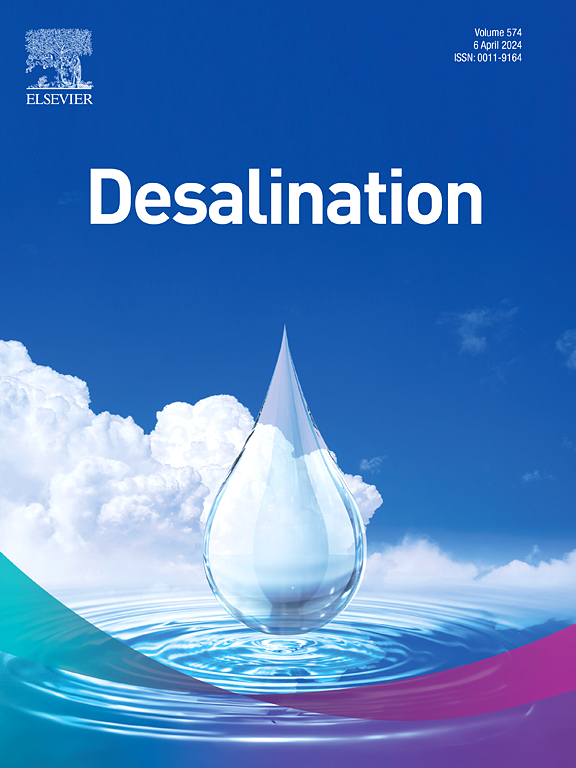分层COF中空纤维的动态共价组装用于选择性染料修复
IF 9.8
1区 工程技术
Q1 ENGINEERING, CHEMICAL
引用次数: 0
摘要
由于传统的粉状有机框架在可回收性和二次污染风险方面面临严重限制,通过共价有机框架(COFs)修复有毒染料污染物是一种有希望但具有挑战性的可持续水净化策略。在此,我们引入了一种范式转换方法,将模板辅助静电纺丝与室温动态共价化学相结合,以制造分层多孔的tpt - tfpt COF中空纤维,从而解决了这些瓶颈。合成的纤维具有晶体有序的2.2 nm孔隙,高表面积(1402 m2 g−1)和可靠的化学/热稳定性。这些结构优点转化为前所未有的刚果红(CR)吸附性能,最大容量为3670 mg g - 1(比最先进的COFs高3-15倍),尺寸选择性去除效率,以及综合吸附指标,包括快速动力学(6小时内去除95%),pH适应性(在pH 2-12范围内效率为50 - 99%)和循环稳定性(5个循环后保持90%)。机理分析表明,化学吸附为主的Langmuir单层吸附受伪二级动力学控制,分子识别由协同孔径匹配、多价氢键和π-π相互作用驱动。这项工作为宏观COF体系结构建立了一个环境水合成平台,同时重新定义了工业规模水处理技术的性能基准。本文章由计算机程序翻译,如有差异,请以英文原文为准。

Dynamic covalent assembly of hierarchical COF hollow fibers for selective dye remediation
The remediation of toxic dye pollutants via covalent organic frameworks (COFs) presents a promising yet challenging strategy for sustainable water purification, as conventional powdered COFs face critical limitations in recyclability and secondary contamination risks. Herein, we introduce a paradigm-shifting approach combining template-assisted electrospinning with room-temperature dynamic covalent chemistry to fabricate hierarchically porous TAPT-TFPT COF hollow fibers, which address these bottlenecks. The synthesized fibers exhibit crystallographically ordered 2.2 nm pores, a high surface area (1402 m2 g−1), and reliable chemical/thermal stability. These structural merits translate to unprecedented Congo red (CR) adsorption performance with a maximum capacity of 3670 mg g−1 (3–15 times higher than state-of-the-art COFs), size-selective removal efficiency, and comprehensive adsorption metrics including rapid kinetics (95 % removal in 6 h), pH adaptability (50–99 % efficiency across pH 2–12), and cyclic stability (90 % retention after 5 cycles). Mechanistic analyses reveal chemisorption-dominated Langmuir monolayer adsorption governed by pseudo-second-order kinetics, with molecular recognition driven by synergistic pore-size matching, multivalent hydrogen bonding, and π-π interactions. This work establishes an ambient aqueous synthesis platform for macroscopic COF architectures while redefining performance benchmarks for industrial-scale water treatment technologies.
求助全文
通过发布文献求助,成功后即可免费获取论文全文。
去求助
来源期刊

Desalination
工程技术-工程:化工
CiteScore
14.60
自引率
20.20%
发文量
619
审稿时长
41 days
期刊介绍:
Desalination is a scholarly journal that focuses on the field of desalination materials, processes, and associated technologies. It encompasses a wide range of disciplines and aims to publish exceptional papers in this area.
The journal invites submissions that explicitly revolve around water desalting and its applications to various sources such as seawater, groundwater, and wastewater. It particularly encourages research on diverse desalination methods including thermal, membrane, sorption, and hybrid processes.
By providing a platform for innovative studies, Desalination aims to advance the understanding and development of desalination technologies, promoting sustainable solutions for water scarcity challenges.
 求助内容:
求助内容: 应助结果提醒方式:
应助结果提醒方式:


